#currently reading some interesting articles about the painting by turner
Text
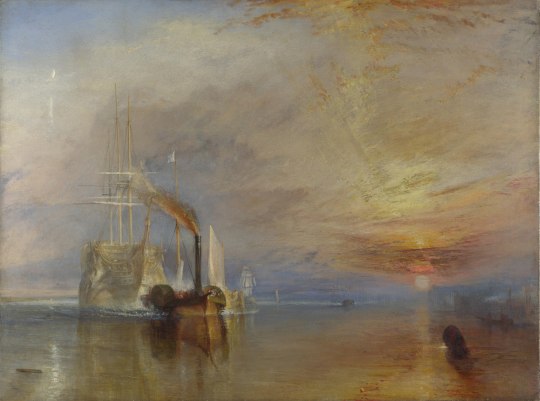
J.M.W. Turner, The Fighting Temeraire tugged to her last berth to be broken up, 1838 (The National Gallery).
I’m starting to see the 1830s as the birth (berth?) of the modern museum ship industry. Notably: there was a public outcry in 1831 when HMS Victory was scheduled to be broken up, which led (eventually) to the ship being preserved; and in the United States, Oliver Wendell Holmes’ poem “Old Ironsides” was published in 1830, leading to national support for the preservation of USS Constitution. I know that both Victory and Constitution had many inglorious years before their eventual state as museum ships, being used as training vessels and tenders etc.; but being spared from destruction in the 1830s when they were obsolete vessels is arguably what saved them.
Was it Romanticism, and opposition to the increasingly industrial world? Steam power was commercially viable in the 1810s, and by the 1820s it was widespread. The Battle of Navarino in 1827 is usually cited as the last major action under sail, but steam-powered ships were seeing military use before that (and I don’t just mean experimental craft). The steamship Diana saw action in the First Anglo-Burmese War in 1824. In any event, 1830s people had to be aware that they were seeing the end of the Age of Sail, and that the last remaining battleships from that era were going to become increasingly scarce.
#age of sail#age of steam#1830s#romantic era#naval history#maritime history#hms victory#uss constitution#The Fighting Temeraire tugged to her last berth to be broken up#currently reading some interesting articles about the painting by turner#museum ship#military history
40 notes
·
View notes
Photo

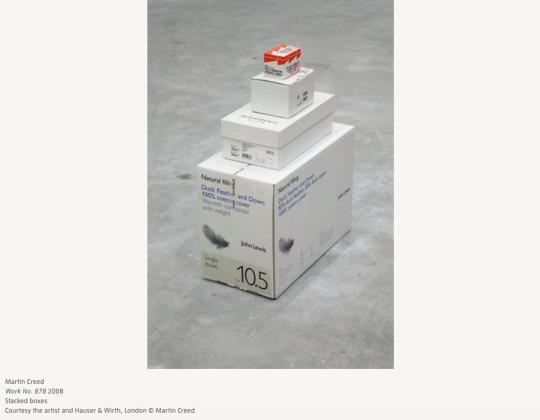
Looking at the history of emptiness in modern art I am often reminded of Zeno’s paradox of Achilles and the tortoise. Zeno imagined a race, in which Achilles would generously grant the tortoise a head start of say 100 metres, and each would move at a steady, unchanging speed. His conclusion was that Achilles would never be able to catch up with the tortoise, because every time he came close, the tortoise would have had time to move a little further, so that the distance between them would endlessly decrease to a few yards, a few metres, one metre, 0.1 metre, 0.01 metre, etc. In the same way, every time the audience of modern and contemporary art is led to believe that the avant-garde reduction of the artwork to a minimal, barely perceptible form can go no further, along comes another artist who creates another even more minimal, even less perceptible, artwork.
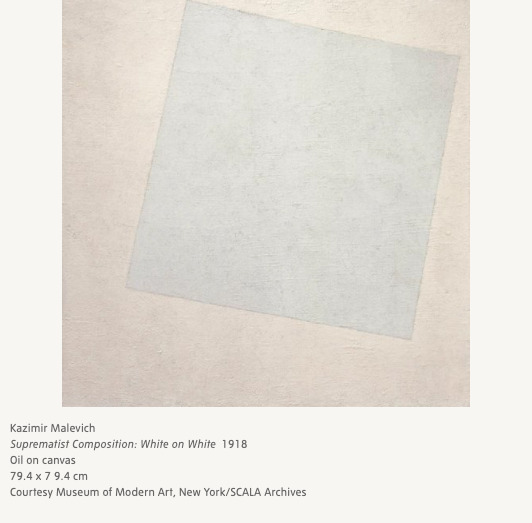
Thus, it seemed that the history of modern art had reached its zero point when Marcel Duchamp presented a glass pharmacy phial filled with Paris air to an American collector in 1919, or when Kazimir Malevich painted his White on White composition in 1918, and two years later filled a room with, as one person noted, empty canvases ‘devoid of colour, form and texture’ on the occasion of his first solo exhibition in Moscow. Yet in a 1968 article, critics Lucy Lippard and John Chandler could only observe that ‘the artist… has continued to make something of “nought” 50 years after Malevich’s White on White seemed to have defined nought for once and for all. We still do not know how much less ‘nothing’ can be.’ Thirty-five years later, Gabriel Orozco’s sole contribution to the Aperto exhibition at the 1993 Venice Biennale consisted of an empty shoe box, eight years before Martin Creed notoriously won the Turner Prize partly for his installation Work No. 227: The lights going on and off at regular intervals. Nearly ten noughty years down the line, and shortly after a museum survey entitled Voids: a Retrospective presented visitors with nine perfectly empty rooms, we are still none the wiser about ‘how much less “nothing” can be’.
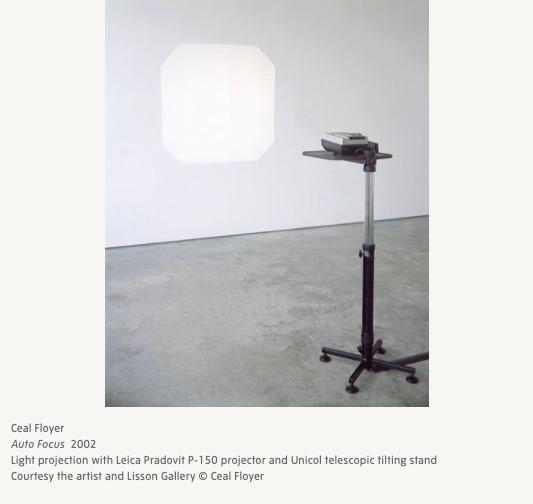
Year after year, decade after decade, however, one thing doesn’t seem to change: if we haven’t walked through, on, or past the artwork without noticing it, our reactions to this kind of barely perceptible, almost nothing, practice will predictably range from puzzlement and laughter to anger and indignation. Even before Malevich’s 1920 exhibition, a French cartoonist had imagined in 1912 that the empty canvas would be the next avant-garde prank visited on its baffled public. In the caption, the artist presenting his blank canvas explains in a pun on the then-current Futurist movement: ‘It’s the most futurist picture of all – so far it is only signed, and I’ll never paint it.’ As the emptiness and reduction of blank canvases, of white or black monochromes and of Duchampian readymades were extended to silent concerts and empty galleries in the second half of the twentieth century, the question remained: are all these forms of emptiness so many variations on the same provocative joke?
The first documented entirely empty exhibition, Yves Klein’s The Specialization of Sensibility in the Raw Material State Into Stabilized Pictorial Sensibility – better known as The Void – at the Galerie Iris Clert in Paris in 1958, certainly had all the trappings of an elaborate PR stunt. Not only did Klein empty the exhibition space and paint the remaining walls and cases white, he also posted two Republican Guards in full uniform at the entrance of the gallery, served blue cocktails especially ordered from the famous brasserie La Coupole and had even planned to light up the obelisk on the Place de la Concorde with his brand of International Klein Blue. While the last event was cancelled at the last minute, an estimated 3,000 visitors did show up on the night of the opening, filling the streets around the gallery as they waited to enter the exhibition space through blue curtains, one small group at a time. The crowd was finally dispersed by the police called in by disgruntled visitors who had felt swindled after paying their entrance fee to be shown an empty gallery. In some ways, the succès à scandale of The Void has obscured Klein’s very idiosyncratic brand of showmanship and mysticism. His interest in the immaterial was genuine, inspired by his exploration of monochrome painting and his belief, influenced by Rosicrucianism, that humans must strive to liberate themselves from flesh and matter.
If some artists since Klein have embraced such spiritual readings of the void, a more general preoccupation with the invisible seems to account for many empty exhibitions in the past 50 years or so. Maria Eichhorn, a German artist whose early work includes white texts written on white walls, speaks for many artists when she explains: “There is such a fixation in our Western culture on the visible, which explains why we think that… a room is empty… because there is nothing visible. But I’ve never thought that an empty room is empty.” In the late 1960s Robert Barry had already pointed to the imperceptible forces that literally surround us by introducing radio waves as well as magnetic currents into the gallery space. American artist Maria Nordman has tried to focus viewers’ attention on the light falling through an empty gallery’s windows at different moments of the day and of the year. More prosaically, other artists have invited visitors simply to contemplate the architecture of the gallery. Arriving in 1993 at the Museum Haus Esters in Krefeld, originally a house designed by Mies van der Rohe, British artist Bethan Huws felt she could not add anything to the beauty of the modernist building. Instead, she distributed a poem to visitors and let them admire the gallery for itself.
In the 1970s American artist Michael Asher pioneered strategies through which to reveal the architectural structure of the gallery. At the Clare Copley Gallery in 1975, for example, he simply removed the wall separating the empty exhibition space from the art dealer’s office. By opening up this space, the artist was not only inviting visitors to consider its architectural features: he also reminded them of the Business transactions taking place behind the walls of commercial galleries. After Asher, other artists have explored the invisible networks of art business and institutional presentations that frame the art we view. Maria Eichhorn used the budget allocated to her show at the Kunsthalle Bern to tackle the institution’s debts and fund much-needed refurbishments of the building (Money at the Kunsthalle Bern 2001), while in their 2005 Supershow – More than a Show, the collective Superflex used theirs to give each visitor two Swiss Francs instead of asking them to pay an entrance fee to see empty spaces adorned only by texts stating the physical properties of each room (surface, wall colour, maximum number of visitors, etc). Museum surveillance is alluded to in Roman Ondák’s 2006 More Silent than Ever, which warns visitors that hidden listening devices are installed in the room.

Presented with invisible elements such as Ondák’s listening devices or Barry’s magnetic fields, we are left wondering whether to believe the artists’ claims since, after all, there is no adequate way to confirm them. We come to realise that our relation to the work is predicated on knowledge, presuppositions and some form of trust in the authority of artists and art institutions. British artist Ceal Floyer traces her interest in minimal displays back to her experience as a gallery invigilator while she was an art student. ‘I watched a lot of art being seen. And a lot of art being not seen,’ she remembers. ‘That was a training in itself. I discovered that presumption is a medium in its own right.’ As with Creed’s The lights going on and off , Floyer’s plastic buckets and black rubbish bags casually sitting in the gallery certainly reveal to us our prejudices and expectations as to what art is or should be. Gabriel Orozco says he actively seeks to disappoint his viewers. Is my irritation at being presented with an empty shoe box or lights going and off ultimately good for me?


The veiled hostility directed by the artist at the viewer situates such attitudes in the context of more radical declarations against art and its institutions. When presenting her empty exhibition at the Lorence-Monk Gallery in New York in 1990, American artist Laurie Parsons went so far as to refuse to include her name on the invitation to the opening and to remove all reference to the show from her CV. Four years later, she ceased to produce works altogether, thus following a line of artists before her who deliberately decided, as part of their practice, to give up, or take a break from, the profession. From this perspective, the empty gallery is less an artwork than a gesture – of provocation, dissent and critique. As Brian O’Doherty has shown in his well-known study of the modern “white cube” gallery, such a gesture ‘depends for its effect on the context of ideas it changes and joins’. For the gesture to succeed, its timing, place and audience have to be just right. Sometimes it can be understood only retrospectively, as it becomes historicised.
It would be unfair, however, to reduce all explorations of emptiness, nothingness and the invisible to the rhetoric of the gesture. To return to Orozco’s Empty Shoe Box: when it was first shown in 1993, it certainly poked fun at the Venice Biennale’s frenzy of publicity and consumption, but it also served as a memorable image of the container or vessel that is a leitmotif in the artist’s work. ‘I am interested in the idea of making myself – as an artist and an individual – above all a receptacle,’ stated Orozco. Playing with contrasts between empty and full, his work as a whole exemplifies a sensitivity to reciprocal spatial relations. In a notebook, he compares discarded pieces of chewing gum on a pavement with the stones placed on a board in the Asian strategy game of Go. Like Empty Shoe Box, the Go stones and the spat-out blobs of gum occupy and cut out space, demarcating a territory according to very specific patterns of chance and intention.

Many artists have similarly been interested in the space between objects. Both the Belgian Joëlle Tuerlinckx and the Brazilian Fernanda Gomes often present arrangements of small, discrete everyday objects scattered around otherwise vacant gallery spaces. Tuerlinckx describes the exhibition space as ‘a kind of parcel, a packet of air’ that she is invited to open and explore through her work; Gomes says she never comes to the gallery with a pre-defined plan. In these installations, the empty gallery becomes a blank page to be inscribed (as in Tuerlinckx’s spatial drawings), or the pregnant void that surrounds objects in paintings such as Giorgio Morandi’s (in Gomes’s three-dimensional still-lifes).
Painting is also a surprising reference for the performances staged by Marie Cool/Fabio Balducci, during which Cool stands in an empty room as she enacts a series of repetitive, extremely precise gestures using flimsy everyday materials such as paper, tape, or thread. The French- Italian duo has claimed that the image of a figure hovering in an undefined yet meaningful space was inspired by early Renaissance religious painting such as Simone Martini’s Annunciations. The empty gallery as a stage for action has also been effectively used by Martin Creed, when he asked runners to sprint down the Duveen Galleries at Tate Britain, one by one at regular intervals, in 2008, or by British-German artist Tino Sehgal, who in 2010 choreographed two continuous scenarios, involving three actors, in the spiral rotunda at the New York Guggenheim Museum.
Placed in vast expanses of void, both bodies and objects appear more vulnerable. On the one hand, such installations provide an alternative to the spectacular displays encouraged by increasingly large-scale museum and gallery spaces. By celebrating the commonplace, the barely noticed, as well as frailty and precariousness, artists thus seem to be actively resisting the pressure to create ever-bigger, glossier, more awe-inspiring works. On the other hand, however, such minimal mises en scène can create new forms of spectacle – as when Maurizio Cattelan places his miniature self-portrait, a resin figurine hanging from a clothing rack, in a corner of the empty gallery in order to emphasise his apparent failure to take on the revolutionary role of 1970s artists such as Joseph Beuys (to make the point, the Cattelan mini-me is clad in Beuys’s signature felt suit).
While such formal devices are often little more than simple gimmicks, works that effectively stage their own weakness and vulnerability can raise questions about the institutional and social conditions that guarantee their existence as art. In Hans Christian Andersen’s tale of The Emperor’s New Clothes, a naked emperor is persuaded by his tailors that his fine clothes are visible only to intelligent people; his subjects, afraid like him to admit that they cannot see them, applaud his outfit until a small child in the crowd finally blurts out the truth – ‘But he’s got nothing on!’ Though above all a cautionary tale against the deceptive powers of flattery, vanity and sycophantism, the story also provides an image of the willing suspension of disbelief required by most forms of art. After all, the artist’s deception, like the cheating tailors’, could never work without our participation. In his 2002 work Lament of the Images, Chilean artist Alfredo Jaar mobilises this kind of community of believers by presenting us with two dark, apparently empty rooms. In the first, we come across three small backlit text panels relating real stories about invisible or impossible images, such as the fact that the United States Defence Department purchased the rights to all available satellite images of Afghanistan during the 2001 air strikes so that the global media could not publish them. The second room houses a single, brightly lit, empty screen. Blinded by its light, we are reminded of our own blind spots – our complicity in the invisibility of certain images and in the existence of many an emperor’s new clothes.
5 notes
·
View notes
Text
Pluralistic: 22 Mar 2020 (Preppers in times of crisis, work-from-home vs smart speakers, scientist's coronavirus painting, DNA Lounge needs help, City Council showdown, Tlaib's trillion dollar coins, plutes are hoarding pandemic supplies)
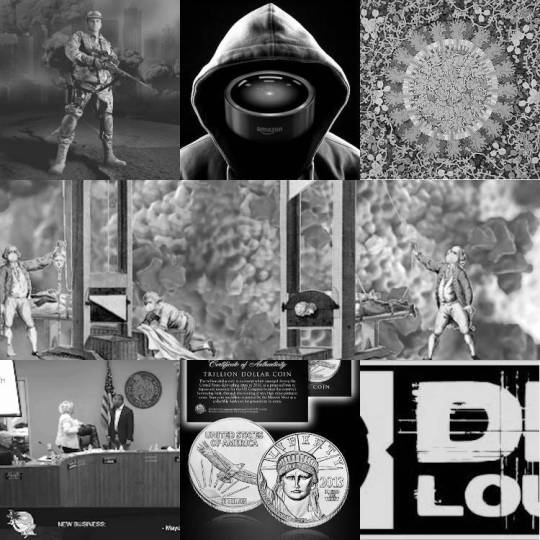
Today's links
How prepper media is coping with the crisis: Fantasy meets reality while grifters pick up the pieces.
Law firm tells work-from-homers to switch off smart speakers: Bugging your own house is not compatible with attorney-client privilege.
Gorgeous painting of coronavirus from a molecular scientist: Free to use, too.
Slim's is shut, but DNA Lounge needs your help: It's not a business, it's a community.
Florida mayor ducks accountability for threatening power disconnections during the pandemic: Mayor Pam Triolo has permanently disqualified herself for public office, and commissioner Omari Hardy has the receipts.
Rashida Tlaib proposes minting two trillion-dollar coins: A people's covid bailout.
How "concierge doctors" supply the "worried well" with masks, respirators and tests: Pandemic capitalism is guillotine capitalism.
This day in history: 2005, 2010, 2015, 2019
Colophon: Recent publications, current writing projects, upcoming appearances, current reading

How prepper media is coping with the crisis (permalink)
I just listened to the most interesting coverage of the pandemic I've heard so far: On The Media's deep reporting on how preppers are coping with the Current Situation.
https://www.wnycstudios.org/podcasts/otm/segments/why-preppers-werent-really-prepared-pandemic
I admit I felt some schadenfreude when I heard prepper media trying to reconcile their hair-trigger belief in the apocalypse with blind loyalty to Trump and his deny/spin tactics. Not to mention some smugness when I heard about all the scammy products grifters are pimping out to preppers. There's even a fucking Kardashian flogging own-brand prepper gear.
But what made the segment amazing – and not just amusing – was the interview with Richard Mitchell, an ethnographer who embedded with preppers for years.
http://people.oregonstate.edu/~mitchelr/
He wrote the canonical book on the prepper movement, Dancing at Armageddon: Survivalism and Chaos in Modern Times.
https://www.press.uchicago.edu/ucp/books/book/chicago/D/bo3637295.html
As Mitchell explains it, prepping is NEVER about actual preparedness. It's about imagining a scenario in which you will uniquely be poised to thrive, irrespective of the likelihood of that scenario. For example, a chemist he profiles in the book is totally prepped for a future in which terrorists poison the water supply and has stockpiled antidotes, water purification chemicals, etc.
The most important thing about this possibility is not that it's likely, but rather than he'd shine if it were to come to pass.
Prepping is a way of playing out a fantasy in which you are elevated to savior status, not an exercise in disaster-mitigation. And the thing is, coronavirus is not a thing anyone can individually prepare for. Individuals in bunkers don't invent novel viral therapies, vaccines, or field-expedient ventilators. That's done by society: labs, research institutes, universities, makerspaces.
The problem with actual prepper-level crises is that they demand social responses, not individual ones. The prepper's quest for individual meaning and supremacy means that he can never be actually prepared, because the way to solve a crisis is run towards it, not away.
Cowering in a luxury bunker trying to unstick the pages of your beloved copy of The Turner Diaries is a hell of a way to while away the end of the world.

Law firm tells work-from-homers to switch off smart speakers (permalink)
Mishcon de Reya is an elite UK law firm whose partners are – like so many others – working from home. The company has issued guidance to staff about shutting down their "smart" speakers while at home, to avoid leakage of sensitive client information
https://www.bloomberg.com/news/articles/2020-03-20/locked-down-lawyers-warned-alexa-is-hearing-confidential-calls
The guidance – to power off these devices – comes from Joe Hancock, the partner in charge of the firm's cybersecurity, and covers all IoT devices with cameras/mics, including baby monitors, smart speakers, Ring doorbells, etc.

Gorgeous painting of coronavirus from a molecular scientist (permalink)
David S. Goodsell is a molecular scientist and artist at the Scripps institute. His latest "Molecular Landscapes" piece is "Coronavirus".
http://pdb101.rcsb.org/sci-art/goodsell-gallery/coronavirus
You can tune into some of the process notes here: "he emphasizes that molecular processes in our body don't stand on their own (despite how they're usually shown in textbooks), but that all these components are part of a crowded environment."
https://www.forbes.com/sites/evaamsen/2020/02/10/what-does-a-coronavirus-look-like/#2b4337f03c7f
Goodsell has declared it "free to use." You can get a high-rez here:
https://cdn.rcsb.org/pdb101/goodsell/tif/coronavirus.tif

Slim's is shut, but DNA Lounge needs your help (permalink)
Two years ago, the billionaires who operated San Francisco's beloved blues club Slim's flogged it off to the predatory venue operator Golden Voice, who have now shuttered it.
https://www.dnalounge.com/backstage/log/2020/03/21.html
As JWZ points out, the fact that Slim's wasn't operated to turn a profit is in no way exceptional. Clubs are labors of love, "We facilitate the creation of culture: You push money in, turn the crank, and what comes out the other side is art, community, music and stories."
He knows. He's run the wonderful DNA Lounge for 30 years: "It isn't some whim of dilettante plutocrats. It's not some hobby I toy with when I'm not private-jetting off to my luxurious doomsday bunker. This is all I do. I didn't expect this to be my life's work, but it is."
He's just about run out of his tech money, and he's had to close during the pandemic, but he's still paying staff and still wants to continue providing a service to his community. He's seeking donations:
https://www.dnalounge.com/donate/
"The 'two or three rich dudes' model is not sustainable, because two or three people, billionaires or not, are not a community."
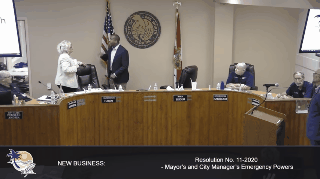
Florida mayor ducks accountability for threatening power disconnections during the pandemic (permalink)
The city of Lake Worth Beach, Florida was brutally slow to recognize the seriousness of the pandemic. Not only did the Mayor Pam Triolo fail to take action to limit the spread of the virus, her administration also continued to send power disconnection notices to the city's poorest residents.
https://www.palmbeachpost.com/news/20200320/watch-coronavirus-florida-lake-worth-beach-meeting-gets-ugly-and-heated-about-emergency-powers
Her administration refused to agendize or properly debate the response for far too long, provoking commissioner Omari Hardy to call her and city manager Michael Bornstein out for their inaction and their cruelty to the city's poorest.
https://www.youtube.com/watch?v=2bgCCXSrwHA
The commissioner's righteous – and technically excellent – intervention during a council meeting is a masterpiece, as he bulls through cack-handed attempts to silence him using mishandled parliamentary procedure, while dogging the mayor as she ducks responsibility.
Forcing people in the worst economic downturn in living memory to choose between spending their last check on power or food, during a once-in-a-century pandemic, is an act of permanently disqualifying depraved indifference and mismanagement.

Rashida Tlaib proposes minting two trillion-dollar coins (permalink)
Congresswoman Rashida Tlaib has revived an idea from the 2011 debt crisis to finance the stimulus, pulled from the #ModernMonentaryTheory playbook: having the Federal Reserve mint two "one trillion dollar coins" and deposit them in its Fed account.
https://www.washingtonexaminer.com/policy/economy/tlaib-proposes-minting-two-1-trillion-platinum-coins-to-finance-monthly-coronavirus-debit-cards
Doing so would avoid federal debt strictures and immediately give the USG $2T to spend on reviving the economy, which it would do by sending every person in the USA a $2K prepaid credit card that would receive $1K/month until a year after the crisis's end.
Each person – children, adults, documented, undocumented, rich, poor – would get the card and the deposits, and progressive taxation would rake it back from those who don't need it (far more reliable than means-testing, which is a persistent failure).
Trillion-dollar coins are a well-theorized and documented proposal. You can read more here:
https://papers.ssrn.com/sol3/papers.cfm?abstract_id=3536440
(Image: Merrick Mint)

How "concierge doctors" supply the "worried well" with masks, respirators and tests (permalink)
One big difference I observed between my life under Canadian medicare (30 years), and UK NHS (13 years) is that in the former, there is no private option, so rich people have to advocate for everyone's care in order to improve their own. I think the relative fortunes of the NHS and OHIP can be largely explained by this difference. Allowing the rich to opt into a private system reduces the political costs of slashing the public system.
In the US, this process proceeds on steriods. Those in the USA lucky enough to have "insurance" find that their massive premiums buy them little-to-no healthcare, with endless bureaucracy and denials.
https://twitter.com/doctorow/status/1240411901055492097
Meanwhile, wealthy Americans buy their way out of the system altogether with "concierge doctors." In good times, this is merely an injustice. During the pandemic, it's an invitation to start building guillotines.
https://www.wbur.org/hereandnow/2020/03/19/nelson-schwartz-coronavirus-inequality
Concierge services have finagled all kinds of pandemic unobtanium: respirators, tests, swabs and masks. These are not going to unwell people, they're going to the "worried well": rich people who just want to be on the safe side.
This could make us all much sicker. We need tests for exposed people, masks for health-care workers, respirators for emergency cases. The fact that these are piling up in mansions in the Hamptons and other wealthy enclaves is proof that markets are not efficient allocators.
We're supposed to tolerate inequality because it is an unavoidable consequence of efficient market allocations, making us all better off in the long run. But when inequality allows plutes to hoard pandemic supplies and endanger every human on Earth, the pretence runs thin.
There's a great book about this, The Velvet Rope Economy: How Inequality Became Big Business, by Nelson Schwartz: "In every realm of daily life–from health care to education, highways to home security–there is an invisible velvet rope that divides how Americans live."
https://www.penguinrandomhouse.com/books/561374/the-velvet-rope-economy-by-nelson-d-schwartz/
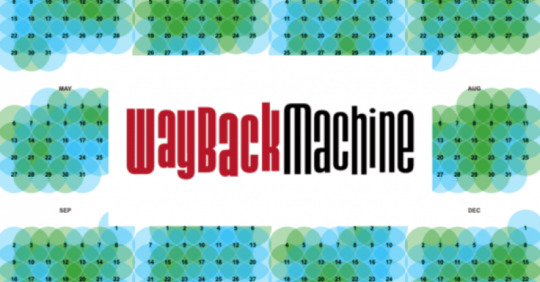
This day in history (permalink)
#15yrsago EFF appeals Apple versus Online Journalists https://web.archive.org/web/20050323164233/http://www.corante.com/copyfight/archives/2005/03/22/eff_files_for_appeal_in_apple_v_does.php
#10yrsago Delusional EU ACTA negotiator claims that three strikes has never been proposed at ACTA http://www.michaelgeist.ca/2010/03/eu-acta-consultation/
#10yrsago Teacher's heartbreak and anger at No Child Left Behind http://lilysblackboard.org/2010/03/nclb-science-of-making-up-stuff/
#5yrsago Taxonomy of theme park narrative gimmicks <a href="https://passport2dreams.blogspot.com/2015/03/the-theme-park-trope-list.html>https://passport2dreams.blogspot.com/2015/03/the-theme-park-trope-list.html
#1yrago Gollancz has published its first anthology of South Asian Science Fiction https://factordaily.com/gollancz-south-asian-science-fiction-anthology/
#1yrago After fatal crash, Boeing reverses sales policy that locked out some safety features unless airlines paid for an upgrade https://apnews.com/140576a8e9d4449eae646c8c479fdc3a
#1yrago Philadelphia city council candidate says his secret AI has discovered disqualifying fraud in the nominations of 30 out of 33 candidates https://www.inquirer.com/politics/clout/council-at-large-petition-challenges-devon-cade-allan-domb-nick-miccarelli-20190322.html
#1yrago This Could Be It: Key Polish Political Party Comes Out Against Article 13 https://www.eff.org/deeplinks/2019/03/could-be-it-key-polish-political-party-comes-out-against-article-13
#1yrago Unnamed stalkerware company has left gigabytes of sensitive personal info unprotected on the web and can't be reached to fix it https://www.vice.com/en_us/article/j573k3/spyware-data-leak-pictures-audio-recordings
#1yrago Wireless vulns in Medtronic's implanted defibrillators allow remote shocks, shutdown, denial-of-service battery attacks and data theft http://www.startribune.com/750-000-medtronic-defibrillators-vulnerable-to-hacking/507470932/

Colophon (permalink)
Today's top sources: Slashdot (https://slashdot.org/). Hugh D'Andrade (http://hughillustration.com/), Late Stage Capitalism (https://www.reddit.com/r/LateStageCapitalism/), Naked Capitalism (https://nakedcapitalism.com/).
Currently writing: I've just finished rewrites on a short story, "The Canadian Miracle," for MIT Tech Review. It's a story set in the world of my next novel, "The Lost Cause," a post-GND novel about truth and reconciliation. I've also just completed "Baby Twitter," a piece of design fiction also set in The Lost Cause's prehistory, for a British think-tank. I'm getting geared up to start work on the novel next.
Currently reading: Just started Lauren Beukes's forthcoming Afterland: it's Y the Last Man plus plus, and two chapters in, it's amazeballs. Last month, I finished Andrea Bernstein's "American Oligarchs"; it's a magnificent history of the Kushner and Trump families, showing how they cheated, stole and lied their way into power. I'm getting really into Anna Weiner's memoir about tech, "Uncanny Valley." I just loaded Matt Stoller's "Goliath" onto my underwater MP3 player and I'm listening to it as I swim laps.
Latest podcast: The Masque of the Red Death and Punch Brothers Punch https://craphound.com/podcast/2020/03/16/the-masque-of-the-red-death-and-punch-brothers-punch/
Upcoming books: "Poesy the Monster Slayer" (Jul 2020), a picture book about monsters, bedtime, gender, and kicking ass. Pre-order here: https://us.macmillan.com/books/9781626723627?utm_source=socialmedia&utm_medium=socialpost&utm_term=na-poesycorypreorder&utm_content=na-preorder-buynow&utm_campaign=9781626723627
(we're having a launch for it in Burbank on July 11 at Dark Delicacies and you can get me AND Poesy to sign it and Dark Del will ship it to the monster kids in your life in time for the release date).
"Attack Surface": The third Little Brother book, Oct 20, 2020. https://us.macmillan.com/books/9781250757531
"Little Brother/Homeland": A reissue omnibus edition with a new introduction by Edward Snowden: https://us.macmillan.com/books/9781250774583
11 notes
·
View notes
Text
A Time Of Change - Chapter Two - New Home
Title: A Time Of Change
Chapter Two: New Home
Summary: Ava Bradford. Behavioral Analyst of the Miami Police Department. Or former Analyst after the events of the past force her to journey to England and take up a job away from the family she had created. Here, she struggles to keep to herself and her life quickly takes over as she readies for her future on Baker Street.
Author: Alexa @alex-awesome1023
Words: 3,352
Characters/Relationships: OC x Sherlock
Warnings: Depression, Anxiety, Past Physical Abuse, Nightmares
Author’s Notes: So I’m a very visual person when it comes to story telling, my fics will have gifs and pictures to best represent and hopefully help you guys see what i’m trying to get across. The chapters might be a tad too long but hopefully they go back to normal length but there will be some longer than others. I don't have a designated schedule for updates yet but I'm thinking every Friday or Sunday. If you have any question or comments please feel free to share. None of the pictures are mine, the credit goes to the wonderful people of google and Tumblr
P.S. I’m going to post my work on @sherlockxreader from now on.
-Alexa
Original Character Ava Bradford is inspired by Zoey Deutch.
Enjoy!❤
After about five minutes filled with non-stop talk of the cab driver's life story about his kids in Kingston, and how he never sees them because of the wife, you try to pass the time by deducing him a little. You look at him from behind, noticing the traces of shaving cream behind his left ear. He lives alone so there’s no one to point it out to him. You look to the front of the cab and notice the photograph attached to the dashboard. Family photo of children, a young boy and girl, the boy’s face looks like him. It’s obvious there was a third person to the left of the photograph but it had been cut along that side to remove most of the woman’s image. Divorced, a nasty one telling by the frame; it’s new but the photo is old. He thinks of his children but doesn't get to see them. A father cast away. She took the kids, but he still loves them. How dull. His clothes are also old but they’ve recently been laundered. Everything he's wearing is at least, what ... three years old? Keeping up appearances but not planning ahead. Why? You make eye contact with the man and quickly smile. He returns with a thin grin but his eyes were void of anything, completely dead. As if you’re mouth had a mind of it own, it speaks your voice, prodding upon the cabby’s now exposed nerves.
“How long has it been since you’ve seen your kids?” You asked, focusing totally on him and his body language.
“Oh um…. It’s been about three or four years.��� He said, his head turned slightly to the left so he could hear. Noting the twitch in his shoulder at your question as well as the clearing of his throat, you could immediately tell that this was a difficult topic for the man. It’s still hurts. Interesting. But there’s more, what is it? He’s a father that has been cast away 4 years ago. He still loves his family but doesn’t get to see them. His clothes are old yet preserved to keep up with appearances. What is i... Oh. Oh that… that is interesting. Very interesting. You couldn’t help but flash a small grin but hiding it before he could see.
“Is that around the same time they told you that you were sick?” It was more of a statement then a question. You locked eyes with him and you see his eyes change.Your phone sounding an alert that you have an email breaks the stares you both share. Quickly letting your train of thought go back to its normal pace, you turn your attention to your phone. You saw that your new boss, the Detective Inspector of Scotland Yard, had emailed you the files of the case they were currently dealing with. He was in need of your expertise.
Looking through the email, you saw that there were in fact three different files and you also noticed that the deaths of those people all appeared as suicides. You wondered why Scotland Yard would investigate suicides of all things but due to the media causing panic for the people, that was probably the reason. People had a funny little way of making havoc out of a grain of sand. Taking out your little black book for notes, you read through the files that were displayed on your phone screen, writing the important details into the book.
The first victim was Sir Jeffrey Patterson, a common business man, who was found at a high-story office building on an empty floor on October 12th in the evening. The cause of death was asphyxiation. You watched the press conference that was held the morning after where the wife explained how he was a happy guy who wouldn’t do this and about how this came suddenly - blah blah blah - however, you did notice the women standing on the far left of the screen, trying to hide tears. You smiled at the image. “The mistress. He was cheating.” This information wasn’t helpful at all though, judging from the behavior of the wife and the mistress, they didn't murder him.
The second victim was only 18 years old. His name was James Phillimore and he was last seen by the friend he was walking with the night of his death. He was found in a sports centre on November 29th. The cause of death, asphyxiation.
The third victim was Beth Davenport, last seen at a public venue and found on a building site in Greater London on January 28th. Death also by asphyxiation. According to the police, there is no connection between the deaths, however, there were sources that said otherwise, and you would have to agree.They all completely disappeared and reappeared, dead, hours later, all dying in what seemed to be in the same manner. But how did they all end up where they did and what was killing them?
You read through the case files once more, taking mental and written notes throughout the articles. You couldn’t think of anything practical that would help the case, well you did but you could do nothing about it while sitting in a cab. Trying not to get frustrated a yourself you locked your phone and took in the sights passing by while you could.

While looking at the streets of London, you thought of Will and how you and him would stay up late and talk about the future, where you’d end up together. You look down to the ring on you right ring finger, twisting it around out of habit. God how you wished he was here with you, congratulating you on going to London and getting the job you always wanted. He was always there for you when you needed him. Feeling a smile creep on your face you sighed, wishing you could go back to those days when everything was carefree and peaceful. When he was still here.
The feeling of the taxi stopping is what pulled you back to the present. Getting out of the cab, you looked at the building, seeing your new home… 220B. You helped the cabbie get your luggage out the back. “Thank you so much for your time and I hope you get to see your children soon. You should try talking to them and your ex wife and tell them the situation you’re in. Try to spend some time with your family, so you can cherish and treasure the moments while you can.” You said, smiling and putting a hand on his shoulder.
“T-Thank you miss, I’ll think about what ya said.” He muttered out, looking at you like you had three heads and told him to suck an egg.
“Is something wrong?” You asked, wondering if you got the fare wrong or said something you shouldn’t have said.
With a half grin, chuckling to himself, he replied. “Oh no miss. Nothin at all. I’ll make sure use my time wisely. You ‘ave a nice afternoon.”
You waved good-bye to the driver and bid him a good day, a genuine smile upon your face as he drove off. Looking up at the building of your new home, you adjust the strap on your shoulder and knocked on the door. Not long after, a woman in her late seventies answered the door.
Taking a quick glance you saw that she wore a lacy, high collared, black blouse, paired with a sweater and a purple shawl thrown over her shoulders. She was dripping with elegance. No wedding band. Does have engagement ring that's at least 50 years old though. The design and wear of the ring itself probably means that she was engaged but never married. Maybe she eloped when she was younger? She reminds me of Professor McGonagall from Harry Potter. Bringing yourself out of your deductions, you greeted her with a smile and introduce yourself.
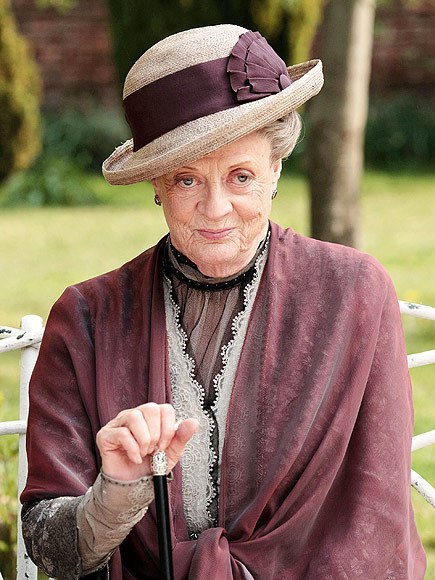
“Hi, I’m Ava who called about the flat. I’m so sorry I didn't call before arriving, it just slipped my mind as I was reading my case files for work.” You took your bottom lip in between your chattering teeth in anticipation, hoping that you hadn’t made a bad first impression.
With a kind and warming smile she ushered you in out of the cold. “Oh that’s quite alright dear, please do come in. I'll make you a nice hot cuppa.”
Dragging your half frozen arse and heavy luggage into the foyer, you took a moment to look at the old, dingy wallpaper and the Victorian style of the whole ground floor, relishing in the dark hardwood floors and staircase leading up to the upstairs flat. Mrs.Turner closed the door and then lead you up the stairs to your new awaiting living quarters. Letting her lead the way, you both walked up the tiny staircase and you couldn't help but bathe in the Victorian setting of the stairway. It was old but also charming and homely. It was the change of scenery you needed. You watched as Mrs. Turner got out a key from the pocket of her sweater and unlocked the old, red, wooden door, the paint peeling in the corners. What a bold color of a door. You huffed out a laugh to yourself and followed her in.

You stepped into the room after her and looked around the flat. It was nothing special, having two windows that looked out into the streets of London. You noticed a sandwich shop across the street, next to a jet black door with a crooked knocker. How convenient but who puts their knocker on crooked? You looked over at the door next to the shop, squinting your eyes to try to make out the numbers above the infernal knocker. You could just barely make out the numbers.
“2...2...1B. So that’s where my aunt lives.” You say loud enough for Mrs.Turner to hear from the kitchen.
“Oh yes, and the very handsome and clever Sherlock Holmes.” You could practically hear the smile on her face as the words left her lips.
“Oh?” You quirked the corner of your mouth, looking over your shoulder at the older woman.
“You should see him dear! Very serious and so kind I’ve heard, at least from Martha.” You smiled at the thought of the two old friends gossiping about the man in the flat as you paced around your new apartment.
“It seems this Sherlock fellow is quite popular around here.” You said crossing your arms and leaning against the opening of the kitchen, watching Mrs. Turner finish preparing the cups of tea and a few cooki- biscuits. Biscuits. If I’m going to be invisible here I have to start using their language.
“I’m not surprised that you’ve heard of him so fast but yes, you could call him popular with the people he’s helped.” She said with a content smile.
“Helped?” Your eyebrow rose in question. “What do you mean helped?”
“He has helped many people around here. He is especially good with legal problems, he once helped your aunt with her husband’s murder charge in Florida two years ago.” She was turned towards you gesturing you to sit at the two person dining table. Florida two years ago? I wonder what part?
“He helped Mrs. Hudson’s husband out of a murder charge?”
“Oh no dear, he ensured it.” Your eyebrows rose into your hairline and your mouth gaped like that of a fish.
“So… so what, is he like a lawyer or a cop of something?” You asked before sitting at the table, sighing at being able to take the weight off your travel tired feet. Mrs. Turner had set the biscuits on a dainty little plate in reach of your hands and the lemon scented shortbread filled you with contentment as you took a bite from one of the sugary snacks. As you chewed, you couldn’t help but to ponder about the ever increasing mystery around Sherlock.
“Oh goodness no, he’s more of a Private Detective. He helps others with problems that need to be taken care of discreetly.” Mrs.Turner took the seat in front of you and sipped at the hot cuppa. So this Sherlock Holmes solves crimes and helps the locals with legal problems that need to taken care of discreetly... So a specialist. Interesting. “But he can be quite rude when he’s dealing with clients or people in general.” She added stopping your train of thought. Your brows furrowed at the comment.
“Well to put it simply, he’s a complete ass.” She said bluntly, looking over her cup before taking another sip. You couldn’t help go wide eyed at the women and nearly fall of your chair because of the sudden burst of laughter that came from your lungs. After all, you’ve never heard an older lady use such language, it took you by surprise. She giggled along beside you and when you had both calmed, she looked past you whimsically, a petite smile gracing her features. “But I will tell you dear, he’s a bit of a lady killer. With those cheekbones of his and his eyes… oh they’re going to be the death of me.” Your lips curled slowly, the gleam in your eyes akin to that of the Cheshire Cat’s.
“Is that a crush I hear in that voice of yours? Are you fond of this man, Mrs.Turner?” You asked with a sly grin. She seemed to come back from whatever daydream she was having, a rouge blush tainting her cheeks as she settled the teacup back onto the table. Your smirk only grew at this revelation and you just couldn’t believe it.
“Oh don’t give me that look, you will see what I’m talking about when you meet him.” She retorted with a light shake of her head.
“Well, I guess I’m gonna have to be the judge of that.” You said before sipping the now lukewarm beverage, feeling the cold outside wash away with the tea.
Relishing in the warmth of the moment, you relax further into the chair. You talked to Mrs.Turner for a good while about different things, like the rules of the flat and the rent, which weren’t a lot and manageable; don’t be loud, have your rent on time, don’t slam doors, and don’t block the walkway or foyer. Mrs.Turner, after a while, saw herself out to go take care of the paperwork on the flat. You took your suitcase up to your room and began to unpack, starting with making your bed.
However, the second you put the fitted sheet on the mattress, your phone went off, startling you and causing the sheet to flick up from the corners and tangle in the middle of the bed. You were scowling when you picked up the device, your face dropping as you looked at your phone to see ‘Unknown’ at the top of the screen, your breath caught in your throat. You couldn't push away the thought that came as a whisper in your mind. What if it’s him? You try to make your voice as steady as possible as you answer the call. “Hello?”
A husky, British voice came on the phone after a few seconds silence. “Is this Ava Bradford?”
“Yes… this is she.” You replied hesitantly, your grip on the phone turning your knuckles white as the tension grew.
“This is Detective Inspector Greg Lestrade. I’m calling about the case files I sent you earlier today.” The voice said and you physically relaxed at his words, the tension rolling off of your shoulders and falling to the floor as you sat on the unmade bed, letting a breath out of your lungs that you didn't know you had.
“Oh yes, sorry. Hi, um, yeah I got the files and have been over them. I was also told that I needed to come in soon. I can be there in a few hours after I unpack a bit if that’s okay.” You bit your nails out of habit and stared out of the window from the rickety bed. I need curtains.
“Yes well I was wondering if you could possibly come in sooner than that? It might be better if you got to meet the team before hand and see what evidence we have on the case so far, it might help you get a reading on it.” Greg said in an exasperated tone, like he just sat down after a run.
“Oh um… yes that shouldn't be a problem I just need to clean up and change. Send me the address and I should be there in no time.” You said trying to sound as content as possible when in reality you had begun to feel stretched thin.
“Alright I’ll text you the address and when you get here, come to my office and I will get you set up.” He said with a kind of excitement in his voice.
“Ok, thank you so much and I will see you soon. Goodbye.” You said, hanging up the phone without hearing a reply. Falling back and laying flat on the mattress, the still rumpled sheet under your head, you stared at the ceiling trying to calm your nerves. Calm down, you're not going to make it if you keep letting your fears and weaknesses show. It gets you nowhere and you’re not going to last. You can't break yet, not now.
Getting up from the bed and having a quick shower, you put on what you thought would be appropriate work attire. Your white “Boyfriend” fit T-shirt, a dark grey loose necked hoodie, and your pink winter coat, and your legs clad in a pair of basic, ripped, black jeans and you favorite converse you’ve had ever since you were a freshman in high school. A pair of black converse with little drawing you did in class AP Chemistry when you were bored. You remember when you got the generic sneaker like it was yesterday, your own quirks making them unique to only you. You had become apart of the family and the siblings wanted to give you something together, they settled on these converse because you had always wanted a pair. You remember the youngest, Nina, giving you the polka dot laces because she wanted them the be “pretty”.


As you laced up your peculiar shoes your phone alerted, notifying you of a message. Seeing that Greg had sent you the address of Scotland Yard with another message underneath.
It’s Greg. This is the address and when you get here just tell them your name and the receptionist should let you up.
You texted him back saying; Okay leaving now.
You grabbed your keys out of the little white bowl on the chipped, baby blue side table next to the door and left your new home, locking the door behind you. Mrs.Turner must have heard your footsteps coming down the stairs because she was coming out of her flat as you got to the bottom.
“Are you heading out so soon dear?” She asked as she saw you fixing your jacket to get ready for the bone chilling weather that awaited for you almost tauntingly
“Yes ma’am. The boss wants me there a little early so I will see too the paperwork later on. I don't know when I’ll be back so don't wait up.” You said over your shoulder getting ready to open the door but you paused and quickly stepped over to Mrs.Turner and engulfed her in a quick hug. “Thank you.” You whispered softly.
She was taken back by the sudden embrace but returned the gesture lovingly. “Anything you need love. Be safe and don’t be too late.” She said with a motherly smile.
“I will. Bye.” You said as you open the door and leave, immediately feeling the London air freeze your nose, making you hug your jacket closer to your body. Closing the door behind you and walking to the curb, you waved down a taxi.
“New Scotland Yard please.”
53 notes
·
View notes
Text
COLLABORATIVE TASK
Please read the article and consider how 'collective' ways of working might be useful to photographic artists.
Artists assemble! How collectives took over the art world
Oliver Basciano
Tue 10 Dec 2019 07.00 GMT
Upon reading this article, I came to the conclusion that spectators create a link between politics and society within the collaboration of artists. Though effective collaborative skills, we are able to create points and a stance against certain political and societal issues; collaborating within the creative umbrella is power.
Jane Hall of Assemble, a group of architects who came together in 2010 and won in 2015, says: ‘Coming together was about trying to refigure power relationships. Recognising that, at a certain moment, the traditional rules don’t apply any more, so there’s nothing to lose in trying something different.’ I agree with this statement in the sense that artists coming together and refiguring power is an achievement and should be hounded and appreciated.
Another factor that stood out upon reflection of the article was the use of identity and sharing identity within collaborations. I believe it is important to come together as artists and use our artistic identity and culture to encourage individuals to work together. It creates power behind a certain identity and our own varied cultures. Shared identity underpins much of the desire to work as a group, says curator Charles Esche : ‘I see what happened in the Turner prize as a gesture that recognises that not everything can be reduced to winners and losers. That’s no dogmatic leftism but something more appropriate to the times in which we find ourselves.’
The idea in which occurred within the article of art coming from a single mind to a single hand which I partly agreed with. However, I do believed that art is created to be shared and appreciated by not on the creator, but with individuals in which it interests and sparks something, an emotion, within them. I trust that the use of artists working collaboratively allows that message to be translated with larger power and meaning as it has been created with alternate and varied ideas and apron approaches. As part of the article states : ‘Within the money game, the idea of the artist is still such a traditional one, the lonely figure coughing up blood in the garret. When we started showing we were asked, ‘How can you make art collectively?’ People had this attitude that art comes from a single mind to a single hand.”
I was surprised to gain knowledge of that collectives make parts of the art work ‘jumpy’. Individuals find it hard to come to terms with the fact that artists are open to collaboration, however, it does that sit well with some. Niru Ratnam, a gallerist and former art fair director, says: ‘Collectives make parts of the commercial art world jumpy. They often form in response to social or political reasons or as a conceptual gesture, which means they are probably going to produce work that is more challenging to sell.’ I can understand how collaborative art may become more challenging to sell due to its diverse response to social or political statements. However, I hope it becomes more excepting and understood. Therefore it will become easier to sell and become a more popular approach to art.
However, there was hope within the article. Sagar goes into detail when describing the political approach and possible outcomes. Sagar believes that collective working should retain its utopian aims and that it can still pose a threat to the prevailing power structures, he states: ‘Collectivity is at the heart of what being leftwing is. Collectives contain the threat of the commons, and that scares the right people, that people can come together and produce complex methods of thinking that might work against capitalism.’
I trust that working collaboratively for photographic artists is definitely an approach that should be considered more. Our use of narrative and the power of the camera is underrated. The amount of power that can come forward within an image is meaningful and can ultimately change individuals views or opinions on topics that are currently relevant in the work for better: using photography as a tool for change. Narula concurs that the pull between optimism and frustration that spurred Raqs to form in 1992 still drives them today. “Working together was born out of a certain attitude in politics and life. At the heart of it, we believe collective action could make the world better.”
Further Examples
I believe that working collaboratively can occur in many forms. Whether its collaborating with an individual that works within the same creative practice as yourself, working with an individual within a different creative practice or working alongside an individual who is able to enhance your work, your practice, to bring forward a larger and more powerful message to a viewer. A collaboration does not necessarily have to occur between two individuals, it may even thrive more effectively within a larger group, a community, that all work in a cohesive manner and create something, a collective action that could make the world a better place.
Pablo Picasso and Gjon Mili: Drawing with Pure Light
It was 1949, and a 68-year-old Pablo Picasso was spending time at his French home in Vallauris when Gjon Mili paid him a visit. At the time, Mili was a photographer for LIFE magazine and had come by to take some pictures of the great artist’s creative process. That’s where an incredible idea was born! Picasso and Gjon decided to collaborate on exploring the possibilities of painting with light. It was Mili who wanted to experiment with this technique, and he convinced Picasso to try making several paintings using the flash of a light as paint and air as the canvas.
Picasso took his assignment seriously. He was so inspired that his hands started moving around in flashing cuts, creating some of the most amazing light paintings, and Mili was there to seize the moment. Their collaboration extended for five sessions resulting in 30 images altogether.
Whether it was Picasso’s signature or a bull-shaped light trail that remained invisible until the photographs were developed, this art collaboration delivered one-of-a-kind artworks.
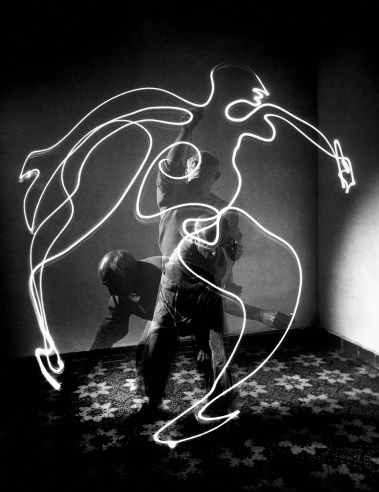
Gjon Mili ©Time & Life Pictures/Getty Images

Gjon Mili ©Time & Life Pictures/Getty Images

Gjon Mili ©Time & Life Pictures/Getty Images
Andy Warhol and Jean-Michel Basquiat: A Crazy Art-World Marriage
From 1980 to 1986, renowned Pop artist Andy Warhol and a graffiti prodigy, Jean-Michel Basquiat, collaborated on a number of exciting pieces that actually led them to the position they now have in the art world. Their working process went on like this: Warhol usually painted first, and then Basquiat entered the scene with his colorful imagery. One of the most popular examples would be the piece titled Olympic Rings, completed in 1985. Warhol actually made several variations of the Olympic five-ring symbol, to which Basquiat responded with the oppositional graffiti style.
How did this “crazy art world marriage”, as Victor Bockris called it in his book, Warhol: The Biography, happen in the first place? It was due to the fame Andy Warhol had already achieved and the fact that Basquiat, a 20-year-old artist at the time, thought this fame was the missing piece which would help him with his big breakthrough in the art world. And he was right! Basquiat’s emotionally-charged paintings and graffiti art were about to become some of the best known Neo-Expressionist artworks in the U.S.
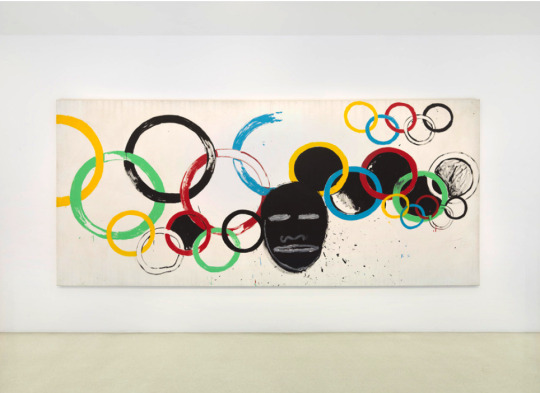
References:
https://www.theguardian.com/artanddesign/2019/dec/10/artists-assemble-how-collectives-took-over-the-art-world
http://resourcemagonline.com/2013/04/light-drawings-by-pablo-picasso-and-gjon-mili/24125/
https://www.agora-gallery.com/advice/blog/2017/04/27/famous-art-collaborations/
http://resourcemagonline.com/wp-content/uploads/2013/04/2_Gjon-Mili-%C2%A9Time-Life-PicturesGetty-Images.jpg
http://resourcemagonline.com/wp-content/uploads/2013/04/3_Gjon-Mili-%C2%A9Time-Life-PicturesGetty-Images.jpg
http://resourcemagonline.com/wp-content/uploads/2013/04/k9l3K.jpg
https://gagosian.com/exhibitions/2012/jean-michel-basquiat-and-andy-warhol-olympic-rings/
0 notes